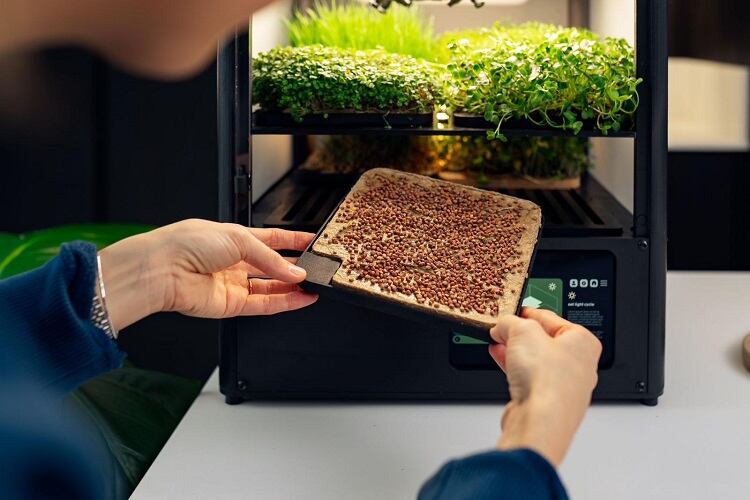The microwave-size device, CROP, can detect the variety of seeds planted and condition its environment accordingly to create optimal growing conditions. This includes energy efficient lighting and water management. The progress of the growing process is also tracked by the system. Finally, its front door has an electronic frosting film that can, should you wish, conceal the growing process.
“At its core, CROP identifies the type of seeds or spores you introduce into its system and tailors the perfect growing conditions for them,” Josh Kay, The Syrup Room's founder, told FoodNavigator. “It integrates advanced technology, including precise light and moisture control, to ensure optimal growth. Simply introduce the seeds or spores, add water to the reservoir, and let CROP take care of the rest.”
The technology, according to Kay, helps provide its users with nutrients that they might not otherwise get.
“Store-bought produce often loses nutrient value due to transportation, storage, and time elapsed since harvesting,” he told us.
“With CROP, you harvest your microgreens and mushrooms right when you're ready to consume them, ensuring maximum nutrient retention. Some of these nutrients include vitamins like C, E, and K, as well as essential minerals and antioxidants.”
Microgreens
One of the key motives behind the technology’s creation was the founders’ interest in microgreens, for the growing of which the technology is optimised well.
“Microgreens are young vegetable greens harvested just after the first true leaves have developed,” Kay told us.
“They are essentially the baby versions of mature plants. Packed with flavour, colour, and nutrients, microgreens have been shown to contain higher levels of vitamins and antioxidants compared to their mature counterparts. These nutrients can boost immunity, reduce inflammation, and provide a plethora of health benefits.”
The CROP technology is well-suited for the growing of microgreens. “CROP provides a controlled environment that eliminates the unpredictability of external conditions. For microgreens, which are sensitive to external elements, this means a consistent light, humidity, and temperature that can boost their growth.”
With its subscription package, CROP offers a selection of microgreens tailored to the diet of the consumer.
Mushrooms
CROP is also well suited for growing a wide variety of mushrooms. They “thrive in low light,” Kay told us, “and require specific humidity levels. CROP's ability to maintain these specific conditions ensures a fruitful and consistent yield.”
What are the benefits of these different types of mushrooms? “Growing specialty mushrooms, like those for medicinal or gourmet purposes, can be beneficial for personal use due to their potential health or culinary advantages,” Kay told us.
“As for those with psychoactive properties, the legality and ethics are complex and vary by region. If it's within legal boundaries, CROP will offer a specialized growing profile tailored to support the growth cycles of these specific mushrooms.”

Growing in an urban environment
According to Statista, in 2021 84.15% of England’s population lived in urban areas. Many people in urban areas do not have access to the resources necessary to grow their own vegetables. CROP, on the other hand, allows people to grow mushrooms and microgreens within their own homes.
“CROP is designed for small spaces, making it ideal for urban environments where outdoor gardening space may be limited,” Kay told us.
“By growing their own microgreens and mushrooms, city dwellers can ensure they're consuming fresh, pesticide-free, and nutrient-rich produce, thereby promoting a healthier diet.”
While it is currently focused on individuals, in the future, CROP could even be used to help communities grow food as well. “While the primary focus may initially be on individual users, the potential to scale up CROP for communal use aligns with the ethos of promoting healthy, accessible food for all. Collaboration with social housing projects could make this a reality in the future.”





